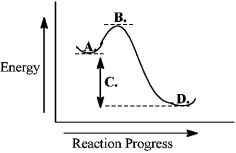A) proton donor
B) proton acceptor
C) electron pair donor
D) electron pair acceptor
F) C) and D)
Correct Answer

verified
Correct Answer
verified
Multiple Choice
Which of the following compounds is the strongest acid?
A) CH3CH2CH2COOH
B) CH3CH2CHClCOOH
C) CH3CHClCH2COOH
D) ClCH2CH2CH2COOH
F) All of the above
Correct Answer

verified
Correct Answer
verified
True/False
An acid with a low pKa is a strong acid and has a weak conjugate base.
B) False
Correct Answer

verified
Correct Answer
verified
Multiple Choice
Which of the following is the strongest acid?
A) HCl
B) HI
C) HF
D) HBr
F) All of the above
Correct Answer

verified
Correct Answer
verified
Multiple Choice
Which of the following is a definition of the activation energy of a reaction?
A) the difference in Gibbs free energy between the reactants and the transition state
B) the difference in Gibbs free energy between the reactants and the intermediate
C) the difference in Gibbs free energy between the reactants and the product
D) the difference in Gibbs free energy between the transition state and the product
F) B) and C)
Correct Answer

verified
Correct Answer
verified
Multiple Choice
Which of the following is the strongest base?
A) iodide anion, I-
B) fluoride anion, F-
C) bromide anion, Br1-
D) chloride anion, Cl-
F) A) and C)
Correct Answer

verified
Correct Answer
verified
Essay
Provide a brief explanation, based on features of the molecules, for the following trend in pKa values? CH3CH2OH > CH3COOH 15.9 4.76
Correct Answer

verified
This trend is best understood in terms o...View Answer
Show Answer
Correct Answer
verified
View Answer
Multiple Choice
Which of the following is a feature of a Brønsted-Lowry base?
A) proton donor
B) proton acceptor
C) electron pair donor
D) electron pair acceptor
F) A) and D)
Correct Answer

verified
Correct Answer
verified
Multiple Choice
Which of the following energy diagrams best represents the changes in energy during addition of HBr to an alkene? 
A) 1
B) 2
C) 3
D) 4
F) None of the above
Correct Answer

verified
Correct Answer
verified
True/False
Consider the following reaction coordinate diagram.  This reaction is endergonic.
This reaction is endergonic.
B) False
Correct Answer

verified
Correct Answer
verified
Essay
Provide a brief explanation, based on features of the molecules, for the following trend in pKa values? CH3CH2OH > CF3CH2OH ethanol 2,2,2-trifluoromethanol 15.9 12.4
Correct Answer

verified
This trend is best understood in terms o...View Answer
Show Answer
Correct Answer
verified
View Answer
Multiple Choice
Which of the following compounds is the strongest acid?
A) CH3OCH3
B) CH3CH2OH
C) CH3CHO
D) CH3CO2H
F) All of the above
Correct Answer

verified
Correct Answer
verified
Essay
What is the value of the equilibrium constant for the following equilibrium? 
Correct Answer

verified
log10Keq = pKa(acid) - pK...View Answer
Show Answer
Correct Answer
verified
View Answer
Multiple Choice
Which of the following compounds is the strongest acid?
A) CF3OH
B) CF3CH2 CH2OH
C) CF3CH2 CH2 CH2OH
D) CF3CH2 CH2 CH2CH2OH
F) C) and D)
Correct Answer

verified
Correct Answer
verified
Essay
Provide a brief explanation, based on features of the molecules, for the following trend in pKa values? CH3CH3 > CH2=CH2 > HCCH ethane ethene ethyne (ethylene) (acetylene) 51 44 25
Correct Answer

verified
This trend is best understood in terms o...View Answer
Show Answer
Correct Answer
verified
View Answer
Multiple Choice
Which of the following is the strongest base?
A) NaOH
B) NaCO3
C) H2O
D) CH3OH
F) A) and C)
Correct Answer

verified
Correct Answer
verified
Multiple Choice
Which of the following is present in the highest concentration upon dissolution of H2SO4 in water?
A) H2SO4
B) H+
C) H3O+
D) HO-
F) A) and D)
Correct Answer

verified
Correct Answer
verified
Multiple Choice
Which of the following has a pKa value of approximately 16?
A) HBr
B) CH3COOH
C) CH3CH2OH
D) HC CH
F) B) and C)
Correct Answer

verified
Correct Answer
verified
Multiple Choice
Which of the following is a feature of a Brønsted-Lowry acid?
A) proton donor
B) proton acceptor
C) electron pair donor
D) electron pair acceptor
F) A) and C)
Correct Answer

verified
Correct Answer
verified
Multiple Choice
Which of the following concepts can be used to rationalize the observation that acetic acid is a stronger acid than methanol?
A) electronegativity
B) resonance
C) valence shell electron pair repulsion theory
D) Pauli exclusion principle
F) All of the above
Correct Answer

verified
Correct Answer
verified
Showing 41 - 60 of 94
Related Exams